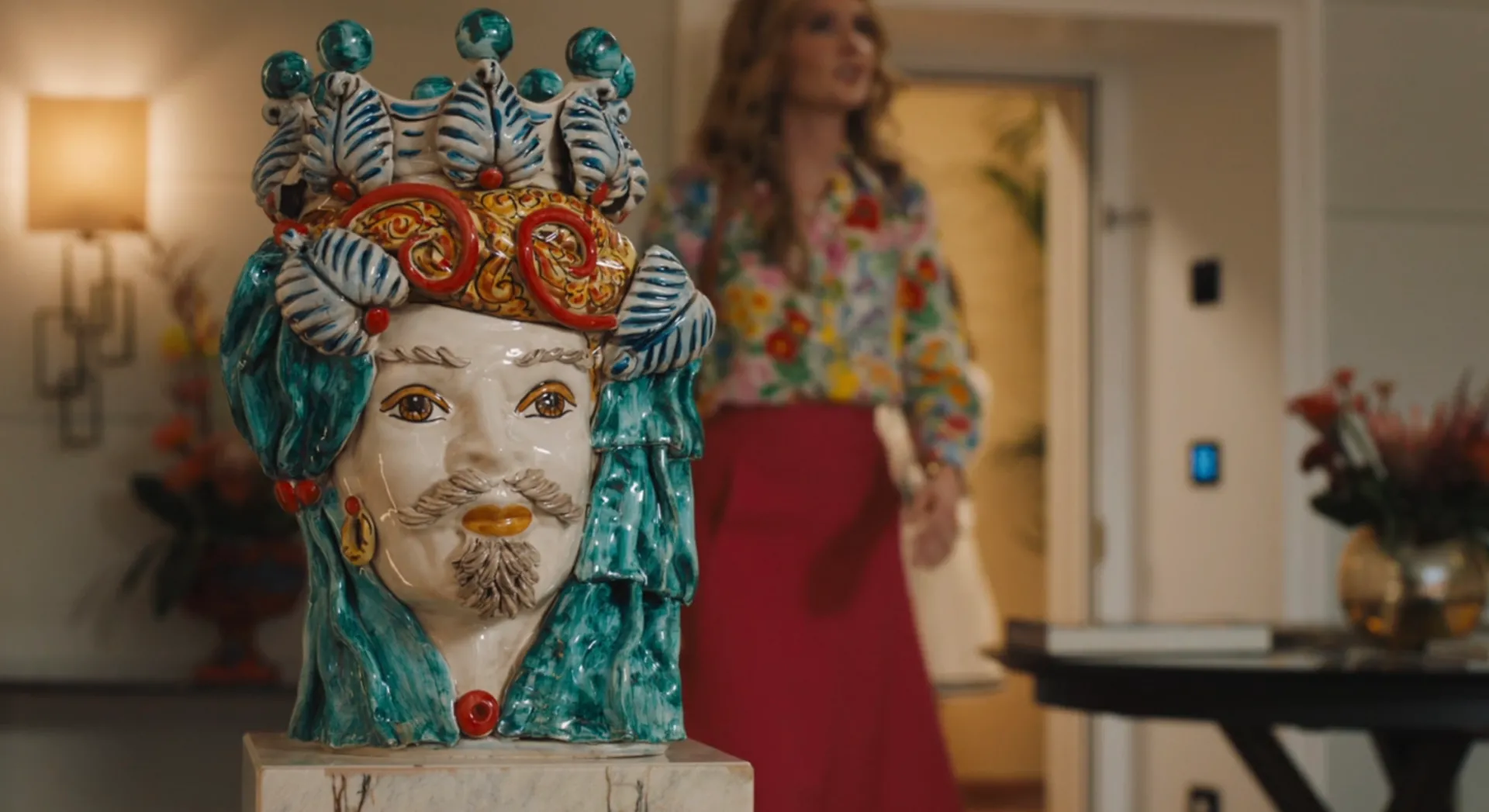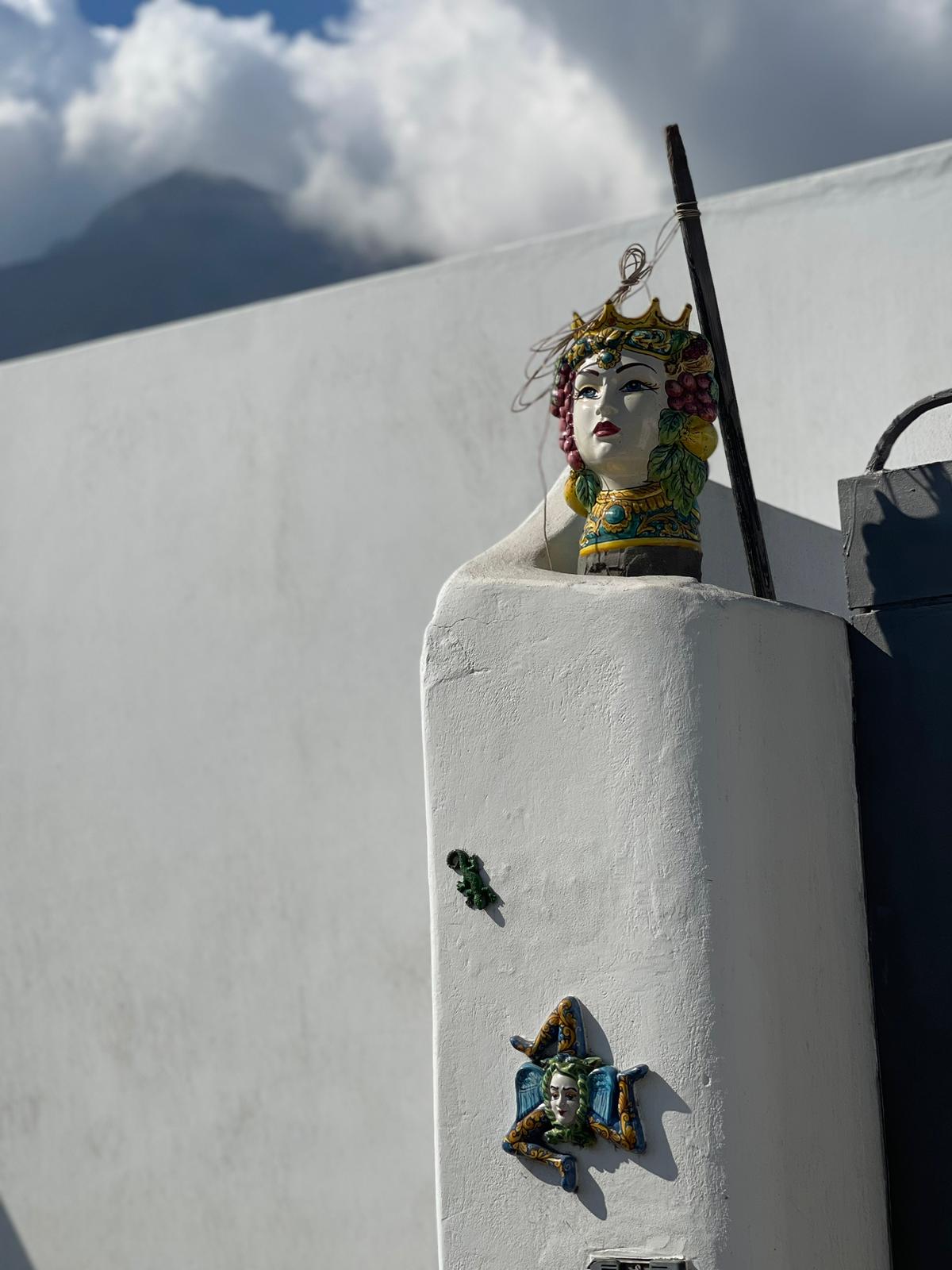If you’ve ever visited Sicily, you know it’s impossible to escape the teste di moro: Sicilian Moor heads. Or perhaps you’ve never been to the island, but have indulged in the latest season of The White Lotus–in which these colorful ceramic heads are cast alongside the likes of Aubrey Plaza, Theo James, and Jennifer Coolidge.
These head-shaped vases are ubiquitous throughout Sicily–put on display at hotels and restaurants, perched on locals’ balconies, and watching passers-by from every shop’s window display. Teste di moro are quite distinct, identifiable by their colorful glazed faces, piercing gazes, and unique headwear, such as a bejeweled crowns or ornate headdresses.
To understand these heads, a brief history lesson is needed about the Moors and their connection to Sicily. The Sicilian capital of Palermo is regarded as the most conquered city in the world–perhaps no surprise, given the island’s location in the middle of the Mediterranean. Arriving from present-day Tunisia, invaders arrived on the shores of Sicily in approximately 827 AD and dominated for the next 250 years. These conquerors were referred to as “Moors”–a term used by Europeans to refer to both Berbers and Arabs from North Africa, as well as those from other parts of Africa and the Middle East. The term went beyond religious boundaries too and encompassed a variety of histories, geographies, and ideologies: above all, though, the expression pertained to the “others” who ruled the island.
The vast popularity of these ceramic Moorish heads derives from a legend tracing back to the 11th century, when the Moors were in the midst of their domination. A beautiful young Sicilian woman, with hair as dark as night and eyes as blue as the Palermo bay, steps out onto her balcony to water her plants when she looks down to see a young Moro merchant gazing up at her. Colpo di fulmine–love at first sight–is ignited, and the two begin an ardent affair. When it’s time for the merchant to return to East Africa, the young lady finds out he has a wife and children waiting for him at home. Enraged with jealousy, she cuts off his head in his sleep and, wanting to possess him forever, uses it as a pot in her garden to grow basil in. Watering the plant daily with her tears, the herb grows to be lush and vibrant–soon attracting the attention of her neighbors. Longing for the same horticultural success, they begin forging ceramic vases with the same features as the Moor’s head, and a new tradition is born. It’s no wonder The White Lotus chose these teste di moro as a prominent prop on-screen, foreshadowing catastrophic infidelity to come.

You’ll also tend to find the hand-painted heads in pairs thanks to another version of the legend: a Sicilian girl with noble origins and a young Moor fall deeply in love with one another, but their respective families forbid the romance and have the young couple beheaded. (Decapitation was a common theme in Sicily; in fact, one of Caravaggio’s most beloved and influential works, The Beheading of Saint John the Baptist, was created during his exile on the island. There’s even a famous street in Palermo–Via de Decollati, or “Street of the Beheaded People”–where severed heads were piled into pyramids and put on display.) Despite the ominous mythology that surrounds the vases, they are stunning, florid works of art. Every testa is different: some come adorned with lemons, pomegranates, or a bouquet of grapes surrounding the crown; others feature prickly pears, cacti, or flowers. The male ceramic heads may sport mustaches and the females long eyelashes.
Sizes and, it’s important to note, skin tones can vary. The most common male and female pairs feature heads aesthetically opposite of one another: the woman portrayed with lighter and simpler features, the man sporting a turban and jewelry. Considering the complex history surrounding the Moors in Sicily, it’s understandable why testa di moro are surrounded by a bit of controversy. Some believe the term “Moor” and the pots themselves to be offensive relics, while others argue that they are symbolic depictions of the island’s cross-cultural history. Either way, we must take into account the fact that the racial undertones of today are much different than they were then; the Moors were the powerful colonizers. No matter which side of the argument one falls on, however, the teste di moro serve as potent reminders: never betray a woman, let alone a Sicilian one.
In addition to the Sicilian Moor’s heads, pigne–or pinecones–also made a cameo in The White Lotus and can be seen lining the shelves of ceramic shops across Sicily. More than just home decor, these pinecones are imbued with symbolism from Sicilian folklore. An ancient symbol of fertility believed to bring good fortune and abundance to all who enter the home, these ceramic pinecones make for a customary housewarming gift in Sicily, particularly for the bedrooms of newlyweds. The pigna was also used in medicinal applications for centuries, as it was commonly believed that pulverizing pieces of the cone could cure illnesses like fever and headaches. In the spiritual world, pinecones represent the third eye–or state of enlightenment.

The art of creating pinecones has been passed down through generations, and many artisans still make them today using traditional methods and materials for glaze, paint, and clay. (With an abundance of clay in the Caltagirone province, Sicily’s roots as a major player in pottery production can be traced all the way back to the 2nd century BC.) Most typically seen in monochrome or with a maiolica base, the pigne, like teste di moro, are made in a variety of shapes, sizes, and colors.
The White Lotus has spurred a heightened interest in Taormina, Sicily and made Moorish heads and pinecones veritable on-screen stars. And, after seeing the fates of our favorites from the hit show, we’ll heed Daphne’s warning. Then again, we could always use a little extra fertilizer for our basil–pasta alla norma won’t garnish itself.








